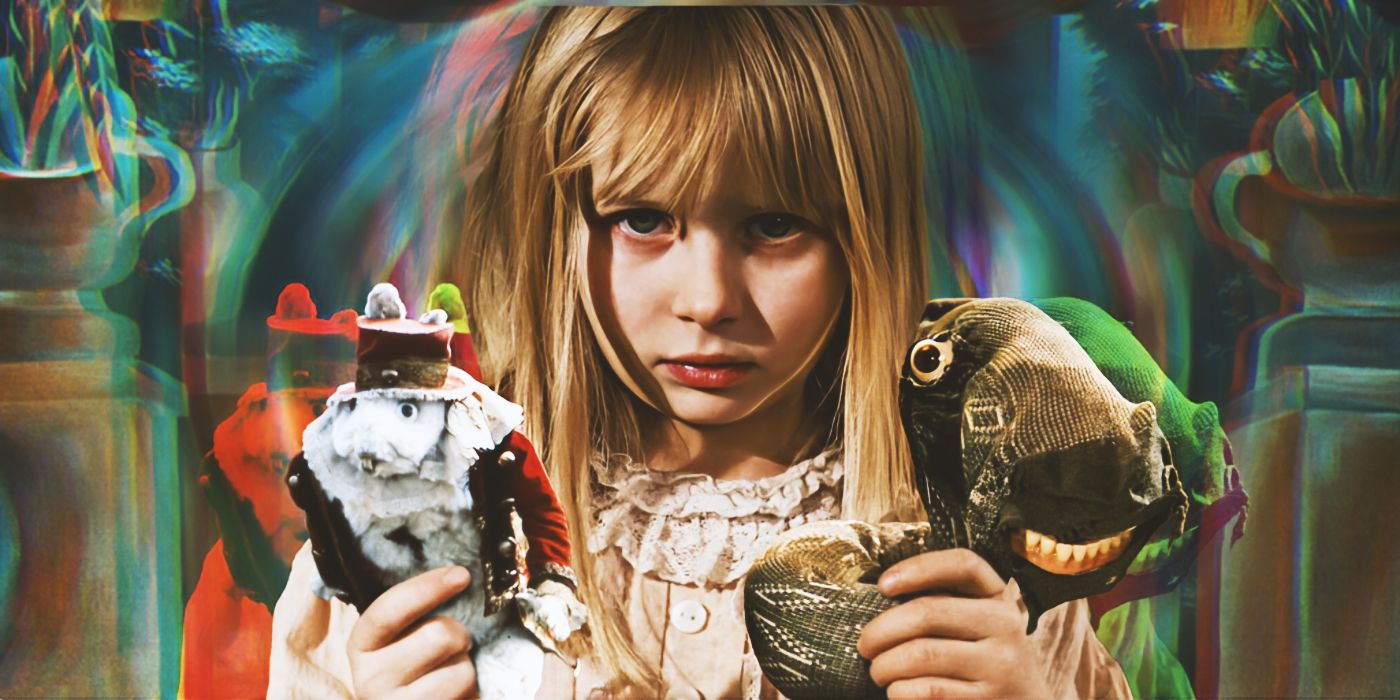
The Nineteen Eighties noticed a wave of darkish fantasy movies that felt like moody fairytales. Some movies, like Neil Jordan’s The Firm of Wolves, are retellings of precise fairytales, whereas others, like Jim Henson’s Labyrinth and Darkish Crystal, are brand-new materials. Constructing on identifiable youngsters’s tales routinely attracts a youthful viewers, particularly when the advertising and marketing for the movie performs up the supply materials. In 1988, Jan Švankmajer launched Alice, one of many darkest variations of Lewis Carroll’s Alice in Wonderland. Nicely conscious of his potential viewers, considered one of Alice’s first strains is, “Now you will notice a movie made for youngsters…maybe.” Half stop-motion, half live-action, Alice sees a younger Kristýna Kohoutová play the titular Alice. The movie follows the essential framework of the unique Alice in Wonderland whereas dilating the surrealist logic and coming-of-age points to unsettle the viewers with a extra subliminal sort of horror. For these who’ve theorized whether or not Alice in Wonderland can be a surrealist horror, Alice is the movie that commits to combining the unique’s strangeness with pointed darkness.
‘Alice’ Suits into the Darkish Fantasy Style of the Nineteen Eighties
Fairytales have an absurdist logic, and nowhere is that clearer than in Alice. There may be little or no dialogue, all spoken by way of close-ups of Kohoutová’s mouth as she speaks for herself and different characters. This sparse dialogue leaves the visuals with a whole lot of heavy lifting to do. Alice‘s aesthetics are tailor-made to unnerve the viewers and assist silently educate the principles of this Wonderland, which is a much more hostile place than within the authentic. In Disney’s movie adaptation of the story, Wonderland is vivid and filled with, because the title implies, surprise. Švankmajer’s imaginative and prescient is eerie and disturbing. Contained throughout the partitions of Alice’s Soviet-era house constructing, Wonderland has grey partitions with peeling paint and white rabbits that bleed sawdust. Nothing is correctly, with a creeping sense of dread constructing each time Alice turns a nook.
Associated
20 Darkish Fantasy Movies Which are as Scary as They’re Inventive
Generally the street to “fortunately ever after” takes some darkish turns.
One of many many strengths of Švankmajer’s Alice is how he warps acquainted characters into becoming his grim aesthetic. Whereas Alice is primarily performed by an precise actress, the opposite characters seem by way of stop-motion. The White Rabbit and the Mad Hatter are grungy, taxidermied animals. The White Rabbit is the primary little bit of Wonderland that Alice encounters, and he’s nothing like earlier iterations. Combining the taxidermied state of the hare with the stop-motion methodology, Švankmajer’s White Rabbit strikes at a fast, rickety clip.
The feeling of watching him jet throughout the display screen is just not not like the primary time a zombie seems in a horror flick, the place the viewers and the character can inform one thing isn’t fairly proper with the way in which the far-off determine is shifting. After the primary close-up shot of the White Rabbit’s yellowed enamel snapping on the digicam, the viewers is aware of they’re in unfamiliar territory. Sock worms with enamel trash throughout the ground at Alice’s ft, creatures with uncovered skulls scuttle round, and the Cheshire Cat has by no means appeared extra terrifying. Everybody Alice meets in Wonderland has a gloss of hazard to their design. The visible language comes throughout as crazy dream logic, besides it is extra of a nightmare.
The Alice of ‘Alice’ Reveals the Scariest A part of This Film
The creepy taxidermied animals and eerie stop-motion should not essentially the most unnerving points of Alice. Peppered all through the movie are close-ups of Kohoutová’s chapped lips, talking authentic strains of textual content from Carroll’s e book. This framing machine, mixed with frequent pictures of Alice’s skirts blowing up and bouts of her turning right into a porcelain doll, provides an additional layer of unease to the movie. At one level, whereas a doll, Alice will get trapped in a room filled with specimen jars. This overt commodification and objectification of Alice clues the viewers into Švankmajer’s particular curiosity within the coming-of-age facet of Alice in Wonderland.
Many darkish fantasies of the Nineteen Eighties inform the story of a teenage woman coming into her personal, typically by way of the lens of her sexual awakening. Sarah from Labyrinth will get caught in a recreation of cat and mouse with David Bowie’s sexualized Jareth. Rosaleen of The Firm of Wolves performs a much more daring model of Little Pink Driving Hood, with the wolves and the huntsman as her romantic pursuits. However what units Alice aside from them is that she continues to be a really younger youngster. As she progresses, Alice is just not coming of age a lot as having the nastier components of the grownup world foisted upon her within the type of violence, cruelty, and sexualization. One of many uglier points of rising up is the sudden consciousness of others’ undesirable perceptions. Švankmajer places the viewers within the place of being each the topic and the observer. Directly, the viewer is Alice, trapped like several of the specimens within the jars, and in addition one of many animals who locked her in.
Švankmajer’s Alice is a visit. The mash-up of stop-motion and live-action creates an uncanny valley effect, constructing on the surrealist tone of earlier movie variations. Alice breaks new floor by totally committing to only how scary Wonderland may be. Švankmajer’s model of rising up is essentially the most grownup, fleshing out the darker implications of Carroll’s story that Disney glossed over. Alice is nearly as good as a darkish fantasy retelling will get, elevating that authentic eeriness and bringing it to new heights.
Alice is available for purchase or lease on Amazon.
Lease on Amazon
- Launch Date
-
August 3, 1988
- Solid
-
Kristýna Kohoutová
- Runtime
-
86 minutes
- Producers
-
Keith Griffiths
, Michael Havas

